The main diseases of zucchini and their treatment
During cultivation, gardeners often lose their crops due to damage by bacteria and fungi, as well as as a result of an attack by parasites. Zucchini diseases and their treatment depend on the pathogen that affects the planting. To combat the disease, chemicals and folk remedies are used.
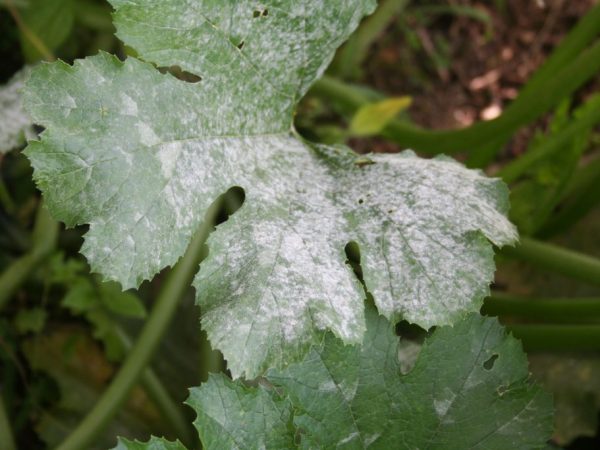
The main diseases of zucchini and their treatment
Bacterial diseases
Like other vegetables from the pumpkin family, squash is susceptible to bacterial diseases, the most common of which is bacteriosis.
The bacterial disease poses a great danger to the squash crop, causing significant damage to the crop. It is caused by the simplest microorganisms - phytopathogens, affects all vegetative organs and subsequently can cause the development of wet rot and root cancer of plants.
Symptoms
- extensive brown spots on the foliage, which subsequently transform into holes in the vein area;
- brown ulcers on fruits, leading to their deformation.
In the process of vital activity and the spread of phytopathogenic bacteria, the vegetable stops growth and development, foliage wrinkles and dies, thickening of cuttings and peduncles occurs, plant organs soften and collapse, turning into a soggy mass.
Diseases appear when:
- sudden changes in night and day temperatures;
- high humidity of soil and environment;
- a large proportion of nitrogen in the soil;
- poor-quality harvesting with the abandonment of weeds;
- planting seeds that have not been disinfected.
Treatment and prophylactic measures
Preventing the appearance of bacterial disease on zucchini is easier than treating them. For the purpose of prevention, properly selected agricultural technology helps, including:
- maintaining moderate humidity in the open field;
- limitation of nitrogen-containing fertilizer complexes;
- timely removal of weeds;
- pre-planting seed treatment, for which zinc sulfate is often used in a solution with a concentration of 0.02%;
- regular ventilation of closed heat and greenhouses;
- preventive spraying of plantings with copper-containing means of contact or combined exposure (for example, chlorine oxide in a solution with a concentration of 0.4%).
Bacteriosis is treated by first removing the affected areas and infected fruits from the plants, followed by treatment with 1% Bordeaux mixture.
Fungal diseases
Copperhead
In the common people, copperhead, or scientifically anthracnose, is a fungal disease of zucchini that can affect all the vegetative organs of a plant.
Vegetables grown in greenhouse and greenhouse conditions have a predisposition to anthracnose.
When cultivating zucchini in the open field, this disease is rarely manifested.
Symptoms
- the appearance of brown oval-shaped fragments on the leaf plates;
- covering of roots, stems and inflorescences with brown specks with a pinkish bloom.
As the fungus develops on the zucchini, the fruits begin to wrinkle and rot, and instead of brown fragments, holes form on the leaves.
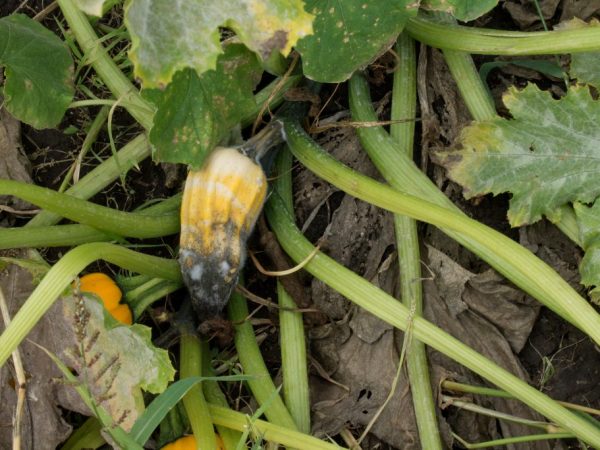
When exposed to the fungus, the fruits begin to rot
When anthracnose attacks the root system, the plant cannot be saved.
A number of factors contribute to the appearance and development of the disease:
- excessive watering in the open field in hot weather;
- waterlogged soil and high environmental humidity;
- poor-quality harvesting of vegetation remaining after harvesting.
Treatment and prophylactic measures
Preventive measures allow to avoid the appearance and development of fungal anthracnose:
- thorough cleaning of the sown area in the fall in preparation for the winter season;
- regular destruction of weeds;
- observance of crop rotation with the correct selection of predecessors and a change in the planting site of related crops every 3-4 years;
- maintaining soil moisture at a moderate level;
- pre-sowing treatment of seeds, for which they often use a raster of boron, copper and manganese with a concentration of 0.2%;
- watering the foliage as the plant grows with biological products (for example, phytosporin) with an interval of 14 days.
When the primary symptoms of anthracnose appear, therapeutic measures are immediately taken: they spray the plants, for which they use Bordeaux liquid (for 10 liters of water, 100 grams of copper sulfate and 100 grams of limestone), colloidal sulfur in the form of a paste with a concentration of 35% (from 40 to 100 grams per 10 l of water) or a polycarbocide in a solution with a concentration of 0.4%.
When vegetables grown in greenhouses and hotbeds are infected with a fungus, the structures are disinfected with bleach, diluting 200 grams in 10 liters of water. Massive defeat of squash plantings is the reason for their destruction.
Sclerotinia
Sclerotinia, or white rot, is a fungal infection of zucchini caused by the phytophage fungus of the same name. Leads to a significant decrease in yield indicators.
Symptoms
- leafy and fruit cuttings, stems and root system are covered with a dense cotton-like bloom of white color, on which fungal spores become visible after a while;
- the affected vegetative parts soften, become covered with a slippery coating and die off.
Favorable factors for emergence and development:
- low temperatures with a simultaneous high moisture content of the soil and the environment;
- thickening of the bushes;
- non-compliance with the basic rules of crop rotation;
- excess nitrogen in the soil.
Treatment and prophylactic measures

The disease requires immediate treatment
In order to prevent this disease in squash, they resort to:
- disinfection of soil by spilling with a weak solution of potassium permanganate;
- calcining the substrate before planting seeds for seedlings;
- regular inspection of plants for the appearance of rot and timely removal of affected areas;
- foliar dressing with urea and copper sulfate (2 grams of copper, 10 grams of urea per 10 liters of water).
When the primary signs of white rot appear, squash is sprayed with Bordeaux liquid with copper sulfate (100 g of limestone, 10 l of water, 100 g of copper sulfate).
To stop the process of reproduction of the fungus, dusting the affected areas with mixed in equal proportions copper sulfate and chalk or crushed coal allows.
Root rot
The causative agents of root rot are pathogenic fungi that can be active for a long time in the soil layers.
The disease leads to a slowdown in the development of the plant: vegetables grow smaller in size, the foliage becomes smaller and becomes yellowish, the ovaries fall off.
Symptoms
- constrictions on the roots;
- discoloration of the root collar, the root itself and the stem to brown with their subsequent decay;
- yellowing and deformation of the lower leaf layer;
- the ruggedness of the vessels on the cut of the stem.
Favorable factors:
- sudden changes in temperature;
- weakened plant immunity;
- watering with water with a low (less than 20 ° C) temperature;
- poor-quality cleaning of weeds;
- exceeding the rate of application of fertilizing complexes.
Treatment and prophylactic measures
As preventive measures:
- comply with the basic requirements of agricultural technology;
- give preference to foliar feeding.
If primary signs of root rot are detected when caring for vegetables:
- pour a layer of soil closer to the stem to activate the process of formation of new roots;
- squash is sprayed with copper-containing agents designed to combat pumpkin root rot.
Plants affected by root rot are removed, and the place of their previous planting is disinfected with copper sulfate.
Powdery mildew
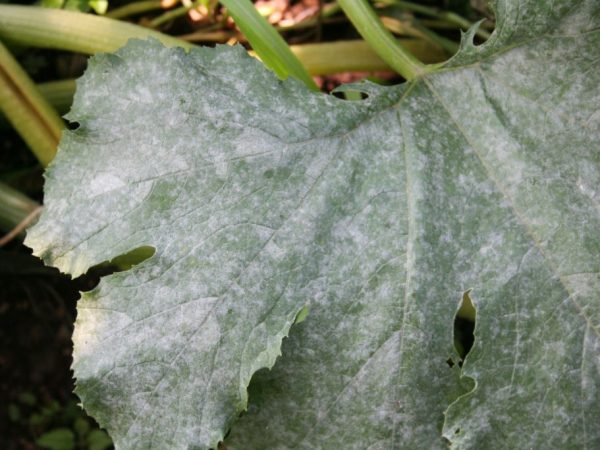
Powdery mildew infects leaves
Powdery mildew has a fungal etiology and mainly affects the foliage of zucchini, but in some cases it is observed on the stem and cuttings.
Symptoms
Whitish spots on the leaf blades, which subsequently increase in diameter, merge into a single whole and lead to the death of the leaf.
A number of factors favor the appearance of powdery mildew:
- waterlogged soil;
- excess nitrogen in the soil;
- poor-quality cleaning of the landing area with the preservation of weeds.
Treatment and prophylactic measures
In the fight against powdery mildew, they use medicinal treatments:
- spraying with colloidal sulfur (20 grams per 10 liters of water);
- ground gray powder (300 g per 100 sq. m of planting area);
- spraying with sodium phosphate (50 grams per 10 liters of water).
Minor damage to foliage by a fungal pathogen is cauterized with mullein infusion (1 kg per 3 liters of water, kept for 3 days, filtered and diluted with 1 liter per 3 liters of water) or sprinkled with ground sulfur.
Peronosporosis
Powdery mildew should be distinguished from fungal downy mildew, or downy mildew, similar in description.
Symptoms
- lesions have an oily character and a yellow tint;
- a gray bloom appears on the lower part of the leaf, containing fungal spores.
The same factors contribute to the appearance and spread of the fungus as with powdery mildew.
Treatment and prophylactic measures
As a preventive measure, pre-planting disinfection of seed material and adherence to agricultural practices are used. Root dressings are replaced with foliar dressings containing zinc, boron and molybdenum.
When primary signs appear, vegetables are sprayed with potassium permanganate in a solution (2 g per 10 l of water), biological products, with a massive lesion - with fungicidal agents with alternating systemic and contact agents with an interval of 10 and 5 days, respectively.
Black mold
The fungal disease black mold is often referred to as foliar burn, affecting all the vegetative organs of zucchini. It does not have a strong effect on the yield indicators, however, it leads to a decrease in the presentation of the fruits and spreads quickly, remaining on the seeds, in the soil and technical equipment.
Symptoms
- the appearance of small in diameter specks of rounded forms of light brown color, which subsequently merge with each other, form an extensive necrotic spot; rims are formed around the necrosis;
- over time, the foliage dries up, becomes covered with a cobweb black bloom and falls off.
Promotes the development of black mold:
- sharp temperature drops during night and daytime;
- thickening of landings.
Treatment and prophylactic measures
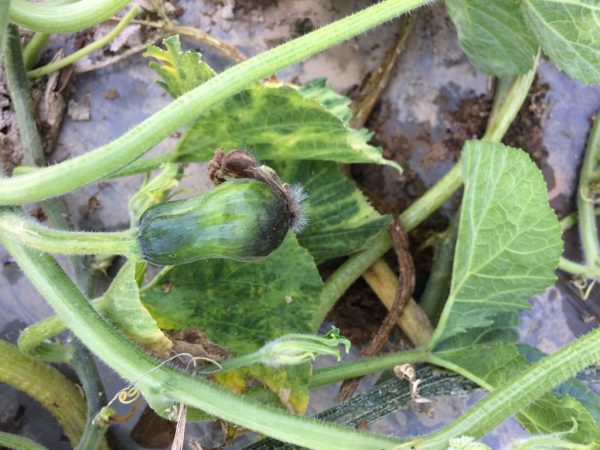
The disease can kill the plant
The main preventive measure against black mold is the pre-planting treatment of seed material and decontamination of the soil with a thorough cleaning of weeds.
To stop the spread of fungal disease, treatment with Bordeaux liquid with a concentration of 1% and copper oxychloride with a concentration of 0.5% allow.
Fusarium
Fusarium wilt, or dry rot, is caused by a fungus, through the release of toxic substances, damaging the vessels of the plant, blocking its supply of food and leading to death.
It is focal in nature, penetrating through the soil and existing wounds on the plant.
Symptoms
- withered foliage and stems;
- diseased specimens do not bloom and do not bear fruit;
- yellowed foliage falls off;
- the roots darken.
Promotes the appearance of fusarium:
- weed vegetation;
- thickening of landings;
- non-compliance with crop rotation;
- an excess of chlorine in the soil;
- weak resistance of vegetable crops.
Treatment and prophylactic measures
The fight against fusarium in the rarest cases leads to a positive result and a complete recovery of zucchini, therefore it is necessary to prevent this disease:
- disinfect the soil with green manure;
- hardening of seed material and seedlings;
- zucchini is sprayed with biological products.
Cladosporium
Cladosporiosis, which has a fungal etiology, is rarely found in zucchini. Primary signs are typical for the middle of the growing season, when flowering and ovary formation begins.
Excessively high (90-95%) humidity favors the development of cladosporium.
Symptoms
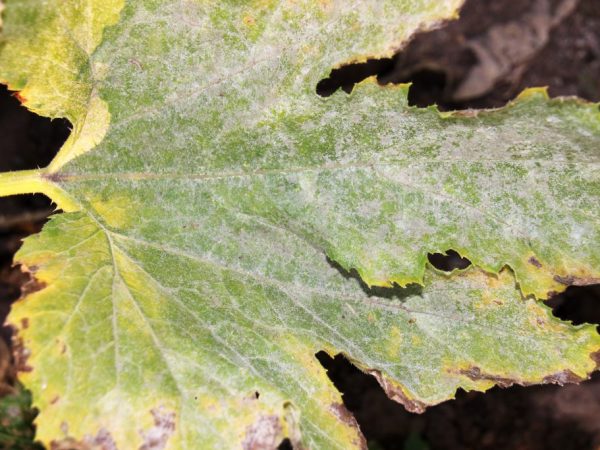
High humidity can cause disease
- yellow spots of different sizes and shapes;
- light bloom on the underside of the leaf, which turns brown over time.
Treatment and prophylactic measures
When combating brown spotting, the main measure is correctly selected agricultural technology.
When treating affected plants, squash is treated with:
- chloride iodine (30 grams of potassium, 40 drops of iodine per 10 liters of water)
- milk whey (1 liter per 10 liters of water);
- garlic tincture (1 clove per 10 liters).
Zucchini viral diseases
Among the viral diseases found in the pumpkin family are green speckled and white mosaics. They infest zucchini on rare occasions. It manifests itself in the form of a color change of the leaf plate and its covering with a mosaic pattern. The sheet curls and wrinkles over time.
The virus spreads with seeds. Therefore, as a preventive measure, pre-sowing seed treatment is:
- warming up at temperatures up to 70'C;
- pickling with potassium permanganate.
Zucchini pest control
Diseases in zucchini often manifest themselves due to the attack on them of insect pests. Meet:
- melon aphid;
- sprout fly;
- whitefly butterfly;
- spider mite;
- slug.
Settling on plants, they feed on their juices and act as carriers of fungal spores and pathogenic microorganisms, leading to the appearance of diseases.
Reasons for the appearance
- non-compliance with agricultural techniques;
- thickening of landings;
- high humidity.
Treatment and prophylactic measures
Treatment of zucchini from pests and prevention of their appearance is carried out for each parasitic insect separately:
- in the fight against the whitefly butterfly, its natural enemies are hooked up - encarzia, macrolophus bug, ladybug;
- against spider mites, zucchini are treated with garlic and onion infusions, decoctions of potato tops;
- mustard, pepper, lavender and sage planted nearby help to get rid of slugs;
- when aphids appear, wiping with soapy water will help to save the squash, the aphid is also afraid of processing with infusions with tobacco (tobacco taken with water in a ratio of 1:10 is infused for 1 day and diluted 1: 3) and with yarrow (1 kg per 10 liters, insisted for 2 days );
- a sprout fly will not take root on a plant if weeds are removed in time and the soil is dug to a sufficient depth.
In case of mass attacks, insecticidal agents are used.
Conclusion
In the process of cultivating zucchini, gardeners are often faced with the defeat of plantings by diseases of various etiologies and insect pests. Treatment of diseases and elimination of parasites is carried out in different ways: folk and with the use of chemicals.The best preventive measure to preserve the crop is prevention.

